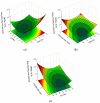Optimization of Combined Ultrasound and Microwave-Assisted Extraction for Enhanced Bioactive Compounds Recovery from Four Medicinal Plants: Oregano, Rosemary, Hypericum, and Chamomile
- PMID: 39683930
- PMCID: PMC11643802
- DOI: 10.3390/molecules29235773
Optimization of Combined Ultrasound and Microwave-Assisted Extraction for Enhanced Bioactive Compounds Recovery from Four Medicinal Plants: Oregano, Rosemary, Hypericum, and Chamomile
Abstract
This study presents the synergistic application of ultrasound- and microwave-assisted extraction (UAE-MAE) as a novel and efficient method for recovering bioactive compounds from the medicinal plants oregano, rosemary, Hypericum perforatum, and chamomile. Extraction parameters, including microwave (MW) power, ultrasound (US) power, and extraction time, were optimized using the response surface methodology (RSM), with ethanol as the solvent. Extracts were evaluated for total phenolic content (TPC) via the Folin-Ciocalteu method and antioxidant activity (IC50) using the DPPH assay. High-performance liquid chromatography with diode array detection (HPLC-DAD) identified the main bioactive compounds contributing to their antioxidant and therapeutic potential. The optimized UAE-MAE conditions enhanced phenolic recovery and antioxidant potential across all plants. Notably, Hypericum perforatum exhibited the highest TPC (53.7 mg GAE/g) and strongest antioxidant activity (IC50 29.8 mg extract/g) under 200 W MW, 450 W US, and 12 min, yielding 14.5%. Rosemary achieved the highest yield (23.36%) with a TPC of 26.35 mg GAE/g and an IC50 of 40.75 mg extract/g at 200 W MW, 700 W US, and 8 min. Oregano's optimal conditions (500 W MW, 700 W US, 12 min) produced a TPC of 34.99 mg GAE/g and an IC50 of 50.31 mg extract/g. Chamomile extracts demonstrated lower phenolic content and antioxidant activity but achieved significant yields under 500 W MW, 700 W US, and 5 min. This study highlights UAE-MAE's superior efficiency, showcasing its potential to maximize phenolic recovery sustainably, making it a promising technique for industrial and therapeutic applications.
Keywords: antioxidant activity; bioactive compounds; extraction optimization; hypericum; medicinal plants; microwave-assisted extraction (MAE); oregano; phenolic compounds; rosemary; ultrasound-assisted extraction (UAE).
Conflict of interest statement
The authors declare no conflicts of interest.
Figures



























References
-
- da Costa J.P. A current look at nutraceuticals—Key concepts and future prospects. Trends Food Sci. Technol. 2017;62:68–78. doi: 10.1016/j.tifs.2017.02.010. - DOI
MeSH terms
Substances
LinkOut - more resources
Full Text Sources
Medical

